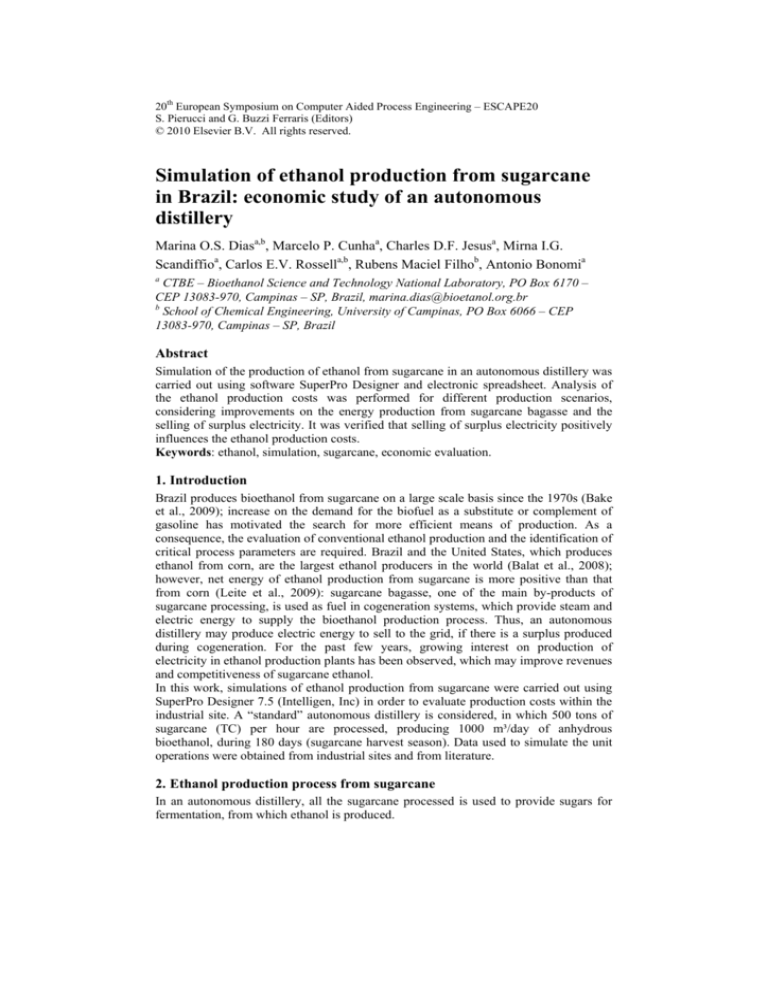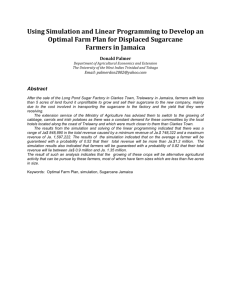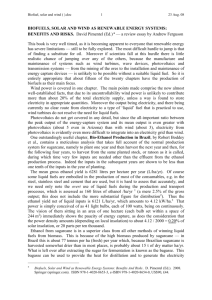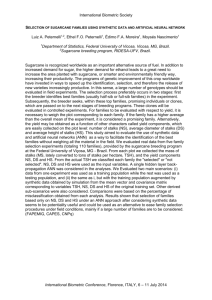
20th European Symposium on Computer Aided Process Engineering – ESCAPE20
S. Pierucci and G. Buzzi Ferraris (Editors)
© 2010 Elsevier B.V. All rights reserved. Simulation of ethanol production from sugarcane
in Brazil: economic study of an autonomous
distillery
Marina O.S. Diasa,b, Marcelo P. Cunhaa, Charles D.F. Jesusa, Mirna I.G.
Scandiffioa, Carlos E.V. Rossella,b, Rubens Maciel Filhob, Antonio Bonomia
a
CTBE – Bioethanol Science and Technology National Laboratory, PO Box 6170 –
CEP 13083-970, Campinas – SP, Brazil, marina.dias@bioetanol.org.br
b
School of Chemical Engineering, University of Campinas, PO Box 6066 – CEP
13083-970, Campinas – SP, Brazil
Abstract
Simulation of the production of ethanol from sugarcane in an autonomous distillery was
carried out using software SuperPro Designer and electronic spreadsheet. Analysis of
the ethanol production costs was performed for different production scenarios,
considering improvements on the energy production from sugarcane bagasse and the
selling of surplus electricity. It was verified that selling of surplus electricity positively
influences the ethanol production costs.
Keywords: ethanol, simulation, sugarcane, economic evaluation.
1. Introduction
Brazil produces bioethanol from sugarcane on a large scale basis since the 1970s (Bake
et al., 2009); increase on the demand for the biofuel as a substitute or complement of
gasoline has motivated the search for more efficient means of production. As a
consequence, the evaluation of conventional ethanol production and the identification of
critical process parameters are required. Brazil and the United States, which produces
ethanol from corn, are the largest ethanol producers in the world (Balat et al., 2008);
however, net energy of ethanol production from sugarcane is more positive than that
from corn (Leite et al., 2009): sugarcane bagasse, one of the main by-products of
sugarcane processing, is used as fuel in cogeneration systems, which provide steam and
electric energy to supply the bioethanol production process. Thus, an autonomous
distillery may produce electric energy to sell to the grid, if there is a surplus produced
during cogeneration. For the past few years, growing interest on production of
electricity in ethanol production plants has been observed, which may improve revenues
and competitiveness of sugarcane ethanol.
In this work, simulations of ethanol production from sugarcane were carried out using
SuperPro Designer 7.5 (Intelligen, Inc) in order to evaluate production costs within the
industrial site. A “standard” autonomous distillery is considered, in which 500 tons of
sugarcane (TC) per hour are processed, producing 1000 m³/day of anhydrous
bioethanol, during 180 days (sugarcane harvest season). Data used to simulate the unit
operations were obtained from industrial sites and from literature.
2. Ethanol production process from sugarcane
In an autonomous distillery, all the sugarcane processed is used to provide sugars for
fermentation, from which ethanol is produced.
M.O.S. Dias et al.
The main steps required for the ethanol production process from sugarcane in an
autonomous distillery are illustrated in Fig. 1.
Figure 1. Simplified block flow diagram of the anhydrous bioethanol production process from
sugarcane in an autonomous distillery.
3. Process simulation procedure
Operating and process parameters of the autonomous distillery were obtained in the
literature and from operating industries. A “standard” plant is considered, with unit
operations typical of those found in the Brazilian bioethanol industry. 500 TC per hour
are processed for production of around 1000 m³/day of anhydrous bioethanol (99.3 wt
% ethanol).
3.1. Simulation
Firstly, a mass balance of the process was carried out using a spreadsheet, in which
usual industrial parameters (efficiency of unit operations, amount of raw materials and
yields) were employed. Then, simulation was carried out using software SuperPro
Designer 7.5 from Intelligen, Inc, considering the unit operations indicated in Fig. 1
except for the operations related to the cogeneration system. In these operations, where
steam and electric energy are produced, calculation was performed using a conventional
spreadsheet, since the simulation software does not have the procedures required to
perform its simulation at the moment. A simplified flowsheet of the simulation of
bioethanol production process is shown in Fig. 2.
Several hypothetic components (sugarcane bagasse constituents, sugarcane impurities,
etc.) were inserted into the simulator database, in order to represent the bioethanol
production process more accurately. Energy demand of unit operations that are not
available in the simulator database, such as extraction of sugars in the mills, azeotropic
distillation and adsorption onto molecular sieves (processes used on ethanol
dehydration), was obtained in the literature (Ensinas et al., 2007; Andrietta, 2009).
The main process parameters are listed in Table 1.
3.2. Dehydration processes
Two dehydration processes were considered: azeotropic distillation using cyclohexane
as entrainer, which is the most common and most energy-intensive process used in
ethanol dehydration, and adsorption onto molecular sieves, which presents the lowest
energy consumption among the commercial dehydration processes available, but
requires a larger investment.
Simulation of ethanol production from sugarcane in Brazil: economic study of an
autonomous distillery
Figure 2. Simplified flowsheet of the simulation of bioethanol production process carried out
using SuperPro Designer.
Table 1. Main parameters adopted in the simulation of the “standard” plant.
Parameter
Sugarcane crushing rate
Days of operation
Fibre on sugarcane
Sugars on sugarcane
Amount of sugarcane trash produced in the fields
Dirt removal on sugarcane cleaning
Sugar losses on sugarcane cleaning
Sugars recovery on the mills
Sugarcane bagasse water content
Recovery of sugars on juice treatment
Fermentation yield
Ethanol recovery on distillation and dehydration
Value Unit
500
180
12
14
140
90
0.8
96
50
99.5
90
99.7
TC/h
days/year
wt%
wt%
kg/TC
%
kg/TC
%
wt%
%
%
%
3.3. Cogeneration system
Conventional plants are equipped with boilers for the production of 22 bar steam, in
which sugarcane bagasse, produced in the mills, is used as fuel. The steam produced in
the boilers is used to produce electricity in steam turbines and as thermal energy for the
process, besides being used in mechanical drivers in the sugarcane preparation and juice
extraction systems.
A 90 bar cogeneration system with back pressure and condensing steam turbines for
production of steam and electric energy is considered as well, in which surplus
electricity is sold to the grid. The amount of sugarcane bagasse available for
cogeneration and the process steam demand are obtained in the simulation and used to
determine the parameters of the coproduction of heat and power (CHP) plant; as a
M.O.S. Dias et al.
result, the amount of surplus electric energy available for sale is determined. The main
parameters of the CHP system are shown in Table 2.
Table 2. Main parameters considered in the simulation of the CHP system (Dias et al., 2009;
Ensinas, 2008; Seabra, 2008).
Value
Parameter
Unit
*
22 bar – boiler thermal efficiency
75
%
90 bar – boiler thermal efficiency*
86
%
High pressure steam turbines isentropic efficiency
72
%
Intermediate pressure steam turbines isentropic efficiency
81
%
Condensation turbine isentropic efficiency
70
%
Mechanical drivers – turbine isentropic efficiency
55
%
Generator efficiency
96
%
Sugarcane bagasse LHV (50 wt% water)
7565
kJ/kg
Sugarcane trash LHV (15 wt% water)
12960 kJ/kg
Electric power demand of the distillery
12 kWh/TC
Mechanical power demand – cane preparation and juice extraction 16 kWh/TC
Electric power demand of the distillery – electric drivers
18 kWh/TC
Outlet pressure of high pressure steam turbine
22
bar
1st extraction pressure
6
bar
2nd extraction pressure
2.5
bar
Process steam pressure
2.5
bar
*
Low Heating Value (LHV) base
Besides the use of more efficient boilers (90 bar), two other process improvements were
considered: the use of electric drives for mills and other equipments, replacing the
mechanical drivers, and the use of sugarcane trash as fuel in boilers. Sugarcane trash is
composed by leaves and tops, and nowadays is burned before harvest or left in the field,
but a fraction of the trash generated may be recovered and used as a fuel in the plant. In
all the cases where excess steam is produced, it is condensed on condensing steam
turbines, increasing the amount of electricity produced. In this work, 50 % of trash is
used as fuel for the production of steam and electricity; the remaining fraction is left in
the fields in order to provide control of weeds and diseases (Hassuani et al., 2005).
4. Simulation results and discussion
Different configurations were analysed, combining the options shown in Table 3.
Table 3. Parameters considered in the studied scenarios.
Parameter
st
1 generation anhydrous ethanol production
22 bar boilers
Dehydration by azeotropic distillation
Dehydration by adsorption onto molecular sieves
Sell of surplus bagasse
90 bar boilers
Burning of surplus bagasse
Sell of surplus electricity
Electrification of drives
50 % of trash used
I II III IV
X X
X
X
X
X
X
X
X
X
X
X
X
X
X
X
X
X
X
X
X
X
Simulation of ethanol production from sugarcane in Brazil: economic study of an
autonomous distillery
Case I presents the typical traditional autonomous distillery; cases II through IV present
increasing levels of technologic improvements considered in this work, which influence
the production of electricity. Simulation results for each of the studied scenarios are
displayed in Table 4.
Table 4. Simulation results for each of the studied scenarios.
I
Parameter
II
III
IV
Anhydrous ethanol production – L/t sugarcane 83.3 83.3 83.3 83.3
Surplus bagasse – kg/t sugarcane
16.6 0
0
0
Surplus electricity sold – kWh/t sugarcane
0 68.2 73.7 154.9
5. Economic evaluation and discussion
On Table 5 the basic parameters for the economic analysis are displayed.
Table 5. Basic parameters used in the economic analysis1.
Parameter
Value
25 years
2 years
US$ 16.58/t
US$ 12.21/t
10 years
34.0%
US$ 0.40/L
US$ 67.05/MWh
US$ 16.58/t
Project lifetime
Salvage value of equipment
Construction and start-up
Sugarcane price2
Trash price (15% moisture)3
Depreciation (linear)
Tax rate (income and social contributions)
Ethanol (producer price)4
Bioelectricity (producer price)3
Bagasse (producer price)5
1
Considered the exchange rate US$ 1.00 = R$ 2.088 (average of the past 12 months)
Average of the last 12 months (UDOP, 2009)
3
Seabra, 2008
4
Average of the last 12 months (CEPEA, 2009)
5
Considered equal to the sugarcane price
2
In order to evaluate ethanol production costs, equipment costs were evaluated for each
of the studied scenarios based on data provided by the industry. Firstly, economic
analysis of each of the studied scenarios was carried out using the parameters presented
in Table 5. Production costs were then calculated reducing ethanol, surplus bagasse and
electricity prices (amount paid to the producer) simultaneously, at the same proportion,
until real profits reached zero (i.e, internal rate of return per year equal to zero). Table 6
presents the investment required on equipments for each scenario and the calculated
ethanol production costs.
Table 6. Investment and ethanol production costs on each scenario.
I
Parameter
II
III
IV
6
Equipment costs – 10 US$
144 185 185 205
Ethanol production costs – US$/L 0.313 0.289 0.286 0.265
Since sugarcane costs are equivalent to roughly 60 % of the final production costs of
ethanol, a sensitivity analysis was carried out in order to evaluate sugarcane costs on the
final ethanol cost; results are presented in Fig. 3 for the four studied scenarios.
M.O.S. Dias et al.
Figure 3. Evaluation of anhydrous ethanol production costs for different sugarcane prices.
6. Conclusions
In this work simulation of a typical autonomous distillery for anhydrous bioethanol
production from sugarcane was carried out. Selling of surplus electricity (cases II
through IV) can improve the profitability of ethanol production from sugarcane, since it
leads to a reduction on ethanol production costs. The use of sugarcane trash as a fuel on
cogeneration systems can significantly reduce ethanol production costs, since large
amounts of electricity are available for sale.
7. Acknowledgements
The authors acknowledge Dedini Indústrias de Base S/A for supplying data for
investment calculations.
References
S.R. Andrietta, Optimal Industrial Fermentation, In: BIOEN Workshop on Process for ethanol
production, FAPESP, 2009. Available online at http://www.fapesp.br/eventos/2009/09/
10_bioen/Silvio_Roberto.pdf, retrieved on sept 15, 2009 (in Portuguese)
M. Balat, H. Balat, C. Öz, Prog. in En. and Comb.Sci., 34 (2008) 551-573
J. Bake, M. Junginger, A. Faaij, T. Poot, A. Walter, Biom. Bioen., 33 (2009) 644-658
CEPEA - Center for Advanced Studies on Applied Economics, 2009, Available online at
www.cepea.usp.br, retrieved on nov 15, 2009
M.O.S. Dias, A.V. Ensinas, S.A. Nebra, R. Maciel Filho, C.E.V. Rossell, M.R.W. Maciel, Chem.
Eng. Res. Des., 87 (2009) 1206-1216
A.V. Ensinas, S.A. Nebra, M.A. Lozano, L.M. Serra, En. Conv. Manag., 48 (2007) 2978–2987
A.V. Ensinas, PhD Thesis (Mechanical Engineering), School of Mechanical Engineering, State
University of Campinas (in Portuguese), 2008
R. Leite, M. Leal, L. Cortez, W. Griffin, M. Scandiffio, Energy, 34 (2009) 655-661
S.J. Hassuani, M.R.L.V. Leal, I.C. Macedo (eds.), Biomass Power Generation—Sugarcane
Bagasse and Trash. Piracicaba: PNUD-CTC, 2005
J.E.A. Seabra, PhD Thesis (Energetic Systems Planning), School of Mechanical Engineering,
State University of Campinas (in Portuguese), 2008
UDOP – Union of Biofuel Producers, Sugarcane prices, 2009. Available online at
www.udop.com.br/index.php?item=cana. Retrieved on nov 15, 2009








